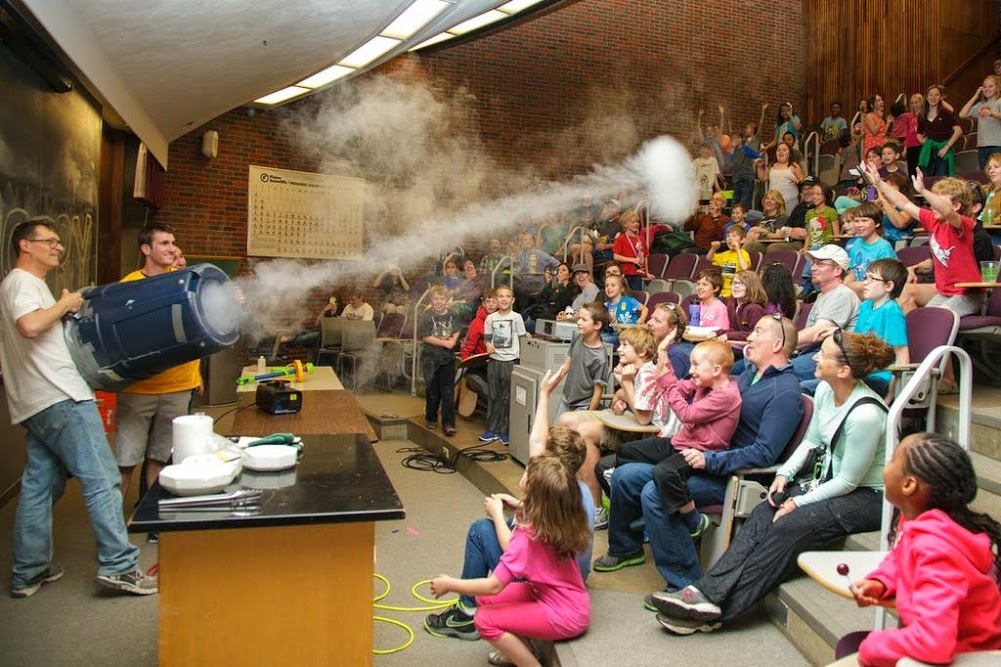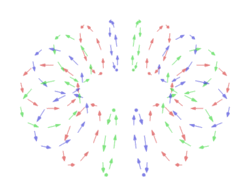Mini Fog Ring Shooter

If you've seen our giant vortex ring shooter (above) at one of our big science shows and wanted one of your own (and who wouldn't?), in this experiment we'll show you how you can be shooting your own miniature fog vortex rings with just an empty plastic soda bottle and a little dry ice. Not only is this lots of fun, but once you have some dry ice (and an adult to help you) there are plenty of other cool science experiments you can also try at home- especially at Halloween!
What you'll need:
- ADULT SUPERVISION!!
- Heavy gloves to handle the dry ice
- Hammer to break up blocks of dry ice
- Spoons or tongs to handle dry ice
- Empty plastic soda or water bottles like those in the photo below
- Warm water
- Dry Ice (you can get some at many grocery stores, Walmarts and 7-elevens. You must be 18 to purchase dry ice.)

IMPORTANT- Dry Ice Safety:
- ALWAYS work with ADULT supervision!
- Dry ice is extremely cold (-110°F), much colder than water ice, so NEVER hold dry ice with your bare hands!
- Always use gloves and/or tongs or spoons to work with dry ice.
- NEVER EVER put dry ice in any closed container (a cooler with a loose lid is okay), as gas pressure will build up until a dangerous explosion occurs which could produce sharp pieces of flying shrapnel.
Basic Experimental Procedure (also watch the video below):
- Add some warm water to your empty plastic bottle, about 1/4 full.
- Have an adult break the dry ice block into small pieces using a hammer and heavy gloves.
- Using tongs or a spoon, add one or two small pieces of dry ice to your bottle of warm water until a nice thick fog starts pouring out of the bottle.
- Gently squeeze the bottle and release to send a puff of foggy air out of the spout.
- With some practice, squeezing the bottle just right- not too hard, not too fast- should send beautiful little fog rings spinning into the air, as in the video below.
- When the fog slows down you can add another chunk of dry ice. When the water gets too cold, dump it out and add fresh warm water.
What's Happening:
We're all accustomed to the changes of state (or phase changes) for water, which changes from solid to liquid (melting) to gas (boiling) as heat is added, and from gas to liquid (condensing) to solid (freezing) as heat is removed. Nearly all substances exhibit these same changes of state as heat (energy) is added or removed, though many require extremely high or low temperatures for this too occur. That's why you will probably never see iron as a gas, or helium as a solid (although you can find videos of very hot iron melting to a liquid, or helium cooled until it becomes a liquid). Some materials are even stranger, and require not only heat but changes in pressure (squeezing) for certain states or phases to occur. Carbon dioxide is one of these strange materials.
Dry ice is really frozen, solid carbon dioxide (CO2). Unlike water ice, however, if we heat solid carbon dioxide (at normal atmospheric pressures) is does not melt to form a liquid, but instead skips directly to the gas phase. We call this process sublimation, and it happens once the temperature of the solid carbon dioxide reaches -109.3°F (-78.5°C). Similarly, cooling carbon dioxide gas to the same temperature causes it to change directly into a solid, which is called deposition. This very cold temperature, along with the fact that no liquid puddle results as it warms, are what makes dry ice so useful for freezing and preserving food or other items.
In this experiment when you add a piece of carbon dioxide to the warm water in your bottle, the water's heat raises the temperature of the CO2, changing it from solid to gas, which is then trapped under water and forms lots of bubbles. Note that these bubbles are filled with CO2 gas, not air. The bubbles quickly float to the surface and pop, releasing the gas which is still very cold. The cold CO2 gas cools the water vapor in the air (we also call this humidity) until it becomes cold enough to condense from gas to liquid. The liquid droplets of water produced are very tiny, so they can float for awhile in the air currents around them until they either warm up and evaporate (i.e. turn back into gas) or collide and combine with other droplets and become too large to float and fall ( i.e. it rains). We call these tiny liquid water droplets suspended in air a cloud, just like those in the sky, or fog when the cloud is near the ground. We can see clouds and fog because the water droplets are large enough to scatter light, unlike the single water vapor (gas) molecules normally all around us, which are much too small to scatter light and thus invisible (to our eyes anyway).
So that explains the fog, but what about the cool vortex rings. When you squeeze your bottle it forces a stream of air out of the mouth. This stream of air (and fog which allows you to see it) is moving very quickly compared to the "still" air outside, which it must push aside to move (of course no air molecules are actually still or motionless, but those in the stream are all moving in the same direction, whereas those outside are only moving randomly in all directions). This is fairly easy for the air molecules in the middle of the stream, as they are surrounded by other fast moving air molecules, but those on the outside of the stream are forced to rub or drag against the still air next to them. This friction slows down the entire circular outside edge of the air stream (and the fog it contains) while the air (and fog) in the center of the stream still moves much faster, causing it to spin (the vortex) into the shape of a donut, called a torus (see the animation below). If you look very closely at a slow moving ring you should be able to see this spinning- it looks as if the donut is trying to twist itself inside-out. Finally, objects which are spinning are very stable and tend to remain spinning in the same direction (think of tops, frisbees, wheels and gyroscopes). This is called conservation of angular momentum. This stability is what keeps the vortex ring together as it slowly moves through the air- and it just looks cool! When the fog slows down you may also notice a dark or clear ring of dry air sucked back into the bottle after each squeeze of the bottle as the sides pop back out.

Additional Dry Ice Experiments:
Now that you have some dry ice (and adult supervision) you can try a few more simple observations and experiments. Place a piece of dry ice in an empty aluminum pie pan and press on it with a metal spoon. You should hear squealing or squeaking sounds as the spoon and pan vibrates. This is caused by heat from the spoon and pan warming the carbon dioxide and changing it from solid to gas (sublimation), which then pushes the ice away from the spoon and pan, causing them to vibrate. You can also place a piece of solid CO2 on the spoon to make it chatter, or squeeze it between two spoons. When the spoons get too cold you can warm them with your hands.
Add a few very small pieces of dry ice (or dry ice dust) to a bowl of warm water and watch as the CO2 gas produced causes the solid pieces to spin and zip along the water surface like little jet boats. Or add a few larger pieces to a bucket of warm water to makes lots of fog. When the fog slows down be sure to observe the little fog rings that form each time a bubble pops. It's like a storm raging inside the bucket!
You can also add a little dish soap to some warm water in a small bowl, then drop in a piece of dry ice to make lots of small soap bubbles filled with fog. We think this looks sort of like a bowl of brains!
Teachers and parents- there are more experiments with dry ice in our teacher's resource pages:
Even more dry ice experiments from other websites:
Links to more information and activities
Wikipedia article for dry ice (including a phase diagram of carbon dioxide versus water):
How clouds form:
Another fog or smoke ring shooter design:
You can also buy the AirZooka:
Make your own giant vortex ring cannon (a quick internet search will bring up many designs):
As the videos on these pages show, big vortex rings can pack quite a punch! That's because even though the vortex ring travels slowly, the air in the ring is spinning very fast.
|